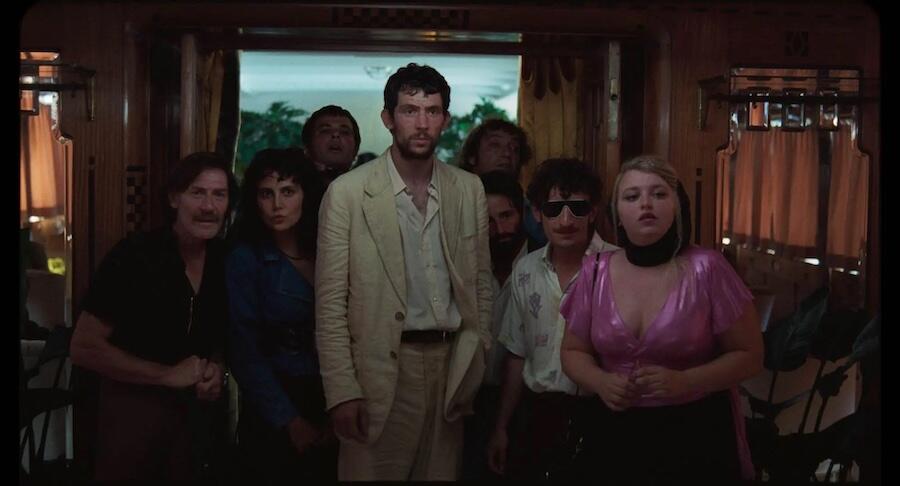Editor’s Picks: The Enchanted Tuscan Cinema of Alice Rohrwacher
Highlights also include Benjamin Mullinkosson’s club kids from Chengdu and intimate gallery sessions in Glaswegian living rooms
Highlights also include Benjamin Mullinkosson’s club kids from Chengdu and intimate gallery sessions in Glaswegian living rooms

Frieze Editor’s Picks is a fortnightly column in which a frieze editor shares their recommendations for what to watch, read and listen to.
La Chimera (2023)
Dewy-eyed and in a loose cream suit, Josh O’Connor chain-smokes his way through Alice Rohrwacher’s La Chimera (2023), a film sometimes tricky to place in time. O’Connor plays Arthur, a dowser-come-archaeologist, in demand for his ability to find Etruscan artefacts buried deep beneath parched Tuscan banks. He is followed everywhere by conditional adoration, including from a rag-tag group of grave robbers of whom he is the de facto leader. The suit becomes increasingly scuffed as the nature of his nefarious work begins to take its toll.

At the film’s core is a rumination on the shape of our dreams (‘La chimera’ translates in Italian to ‘The Impossible Dream’). Isabella Rossellini makes an appearance as a fickle elderly lady (who also fauns over Arthur), and mid-way through, Rohrwacher drops the entirety of Kraftwerk’s ‘Spacelab’ (1978) – what more could you want? La Chimera asks questions about the value of, and trade in, ancient objects but also, more importantly, about who or what our labour and talents serve.
The Last Year of Darkness (2023)
Benjamin Mullinkosson’s documentary The Last Year of Darkness (2023), unfolds like a bumpy moped ride around Chengdu, the capital of China’s Sichuan province, with a bunch of kids from a small club called Funky Town. We meet young punks, a straight-curious male DJ, nascent drag performers and a skateboarder moonlighting as a delivery driver.
Mullinkosson visually weaves the fate of the club, which is under threat from encroaching development, into the industrial fabric of the surrounding city; the film shines most in these moments, where we observe the wider context of the infrastructure and the lives that surround it – a cut from someone writhing around on the floor under a flashing red strobe light to a daytime view of older people playing serene outdoor shuttlecock is a particularly good example.
Mullinkosson’s calm, non-judgmental lens makes even the more clunky segments work. There’s an energy of sometimes aimless observation rather than directedness, an approach that appeals to me. Its fly-on-the-wall nature feels deadpan. More than once, a wasted club kid vomits into a glass or onto the curb after drinking too much.

Exhibitions
The best shows I’ve seen recently have been in converted living rooms in Scotland. Sarah Cameron’s understated ‘Black Socks, No Panties!/The Stone Bouquet from Cologne’ at Glasgow’s Celine is paradoxically generous and opaque, combining nude photographic self-portraits shot in the dark with two murky abstract paintings, one rendered on a canvas first stretched by her father years before. We need more careful, confident shows; I’ve recently seen too much handholding and teachy work that leaves little room for sensuous fantasy and open-ended interpretation.
At the whimsically named Radclyffe Hall – an apartment just a short stroll from Celine – Jamie Crewe’s ‘DEFIXIONES’ is a testament to the artist’s mastery. It features exquisitely detailed portraits, a harp played by the wind perched on a ledge and crumpled pieces of lead cleverly concealed in small crevices.
Finally, 42 Carlton Place, a lone home on a terrace of otherwise abandoned houses occupied mainly by pigeons, presents a series of strange canvases by the deceased artist David Byrd, who was largely unknown during his life. Each image extracts an unusual scene from an auction that, when taken in isolation, appears like an odd work of early surrealism. Glasgow International runs until 23 June. Be sure to check out the off-programme stuff, too.
Main image: Alice Rohrwacher, La Chimera, 2023, film still. Courtesy: The Match Factory






















